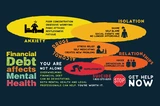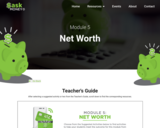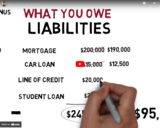
Forget the stigma and shame. Financial expert Bruce Sellery helps you understand bankruptcy and how to decide whether it's the right decision for your family...
- Subject:
- Business
- Financial Literacy
- Material Type:
- Activity/Lab
- Date Added:
- 02/26/2024

Forget the stigma and shame. Financial expert Bruce Sellery helps you understand bankruptcy and how to decide whether it's the right decision for your family...

The material in this lesson will help students become aware of the warning signs of financial difficulties. When difficulties arise, students should first contact their creditors. Next, efforts should be made to revise spending patterns. In addition, assistance from a Credit Counseling service agencies might be considered. What if these actions do not help?

This collection features resources to support teaching Module 26B: Handling Debt Problems B from the Saskatchewan Financial Literacy curriculum. This activity suggests articles, websites, assignments, and discussion topics to help develop some problem-solving skills in relation to managing debt problems.

There are several interesting articles written by Anne Gaviola on Vice focused on Canadian finances, debt, and correlations between money and a person’s well-being. Keeping your debt a secret can mess with your mind and body. The culture of secrecy around debt causes young people to suffer in silence, making it even harder to manage debt. Use this content for case-based learning opportunities.

In this Case Study, students will take on the role of a credit counselor to assist a borrower who finds himself in serious financial distress. Several options will be presented, and students will identify pros and cons of each approach and choose a path forward.

Managing debt loads can be very difficult and overwhelming at times. Hiding from debt and avoiding the problem, will only make the situation worse. This activity includes mini case studies on how to handle various debt problems so that the students can take control of their debt and move forward to a better financial future.

Money StoriesGrounding Indigenous Youth in the Lessons of their EldersWhat is it?Money Stories is a customized money management training program for Indigenous youth. The program combines Indigenous Elders speaking about their experiences with money, with facilitator-led activities about money that are relevant to youth. “We (Elders) need to help the next generation out of poverty. Young people have gifts and talents that should be used. I believe that preparing them for the future, one day they’ll go out into society with the experience and confidence to know they can make it.” Elder Lucy Guiboche.Money stories is delivered in eight chapters. Topics covered include Money, My Community & Me, Building Assets, Goal Setting & Problem Solving, Gathering Information, Budgeting, Banking, and Credit.

Students will learn the consequences of not paying one’s debts and the choices of last resort for out-of-control debt. Students will explain how using [types of predatory loans] can cause a vicious cycle of debt. Bankruptcy is also introduced, and the various costs associated with bankruptcy are outlined. The students will discover what steps a person can take to avoid filing for bankruptcy, including seeing a credit counselor.

Comic Book titled “The Game Plan” by The Healthy Aboriginal Network https://istorystudio.com/wp-content/uploads/2014/04/Game-Plan.pdf The Healthy Aboriginal Network’s Game Plan is a comic book for Aboriginal youth featuring a teenager named Jake who struggled with financial wellbeing until he was taught a lesson or two in financial literacy. Making the right financial decisions helped Jake achieve his goals and feel financially empowered.

This activity allows the students to discuss the burden of student loans and financing post-secondary education. An additional aspect to this activity is the mental health aspect regarding heavy debt loads for post-secondary. The discussion could include a debate on student loans, who is responsible and can a student "walk away" from this debt? Should the government pay for post-secondary education for everyone? If yes, would you be willing to pay more taxes for free post-secondary education?Students often finance their post-secondary education, which can be very expensive over many years. How does a student pay this debt back if they are unable to finish their program, especially in expensive programs such as medicine or law?

The following resource contains the assets (or resources) to accompany the Sask DLC Financial Literacy 20 course.This resources allows you to access all of the Sask DLC supports for Financial Literacy 20 in one place. Course videos and supporting materials (organized by units) are provided.

MyMoneyCoach: This website presents excellent information for students to learn about various types of debt:
- Student Loan Budgeting and Money Management - Practical Tips for Post-Secondary Students: Money Management Strategies -- * Develop a workable budget that also gives you a little money for fun… yes, fun! * If you are using student loans or have enough money saved to get you through, set it all aside in a separate savings account.
- Tips for Paying Off Credit Card Debt: Here are some practical ways you can quickly tackle your credit card debt and take your first real steps toward getting out of debt: * Put your credit cards away until you have completely paid off the outstanding balances.
- Create a Budget to Get Out of Bad Debt - Shed Your Debt Weight: Did you make any resolutions this year? Many people plan to shed the extra pounds that are dragging them down – but does that include weight from your bad debt? It’s amazing how heavy a maxed out credit card can feel!
- How to Get Out of Debt and Keep it that Way: Debt solutions and strategies to get out of debt can vary for everyone, however, the sooner someone is able to deal with their debt, the more options they generally have available to them.

This content covers budgeting and net worth elements that influence financial decisions. Uniquely tailored to Indigenous students’ experiences and histories, Financial Empowerment covers a wide range of topics in financial planning, personal finance, and financial decision-making. Threaded throughout with Indigenous and Canadian content, videos with Elders are also included, offering students their perspectives to enhance the learning experience.

Apply the concept of net worth to various scenarios.
Teacher Guide Included
3-5 hours

Choose from the suggested activities below to find activities to help your students meet the outcome for this module from the Saskatchewan Financial Literacy 20/30 curriculum, Module 26B: Handling Debt Problems, Outcome: Examine the processes of and alternatives to personal bankruptcy in Saskatchewan. All resources for this module’s activities can be found on saskmoney.ca or within this Resource Bank.

Educational animation about credit card debt - part of a series about basic money management for students. These clips were made to complement talks given by comedian James Cunningham. (The character in the cartoon is indeed a real guy)

One of the basic calculations that you should be able to do is figuring out your Net Worth. Once you can do that, you can start to monitor it over time to help see how well you are managing your finances.

When the value of an asset falls below the outstanding balance on the loan used to purchase that asset. Negative equity is calculated simply by taking the value of the asset less the balance on the outstanding loan.

What is Equity? Equity is a term used in accounting, in real estate and home-ownership, in investing, as well as in startup financing and valuation. The meaning of the term equity is very similar in the various areas where it is used, so it will be good to review all four of these to get the best understanding.
In accounting, equity is a term that you will find on the balance sheet. What you own is on the left: assets. What you owe is on the right: liabilities and equity. Equity is the book value of the shareholder capital. The accounting equation tells you that assets equal liabilities plus equity. That also means that equity equals assets minus liabilities.
Equity on a balance sheet goes up when a company is profitable: the net income for the year gets added to equity through retained earnings. Equity on a balance sheet goes down when the company is loss-making (losses “eat up” the equity), or when the company pays a dividend to its shareholders.
Equity in home-ownership works very similar to equity on the balance sheet. What we own is on the left: the house worth $500.000. What we owe is on the right: $400.000 of mortgage loan from the bank, and the owner of the house, Jim, has $100.000 of equity in the house. Equity in home-ownership is what a home is worth minus how much you owe to the bank.
Just like equity on the balance sheet of a company can go up or down, the equity that you have in your home can go up or down. If Jim is paying down the mortgage on his house by $50.000, then the amount of the loan outstanding will decrease and his equity in the house will increase. If the market value of the house increases, then Jim’s equity in the house will increase. Remember that equity is what a home is worth minus how much you owe to the bank. If the market value of the house decreases, then Jim’s equity in the house will decrease, or even become negative. Jim will need to have a conversation with the bank to make a remediation plan to get back to positive equity, or in the worst case scenario Jim might lose the ownership of the house and the bank will need to take a partial write-off of its outstanding loan.
Investing in #equity. Remember the example of the small manufacturing business that owned a machine, had a loan from a bank, and equity from one shareholder. What if we make that a big manufacturing business that owns lots of machines at different sites totaling $1 billion, has many loans outstanding totaling $800 million that are publicly traded in the bond market, and has many different shareholders as the certificates of ownership, the equity, is traded publicly as well. As an investor, you have the choice of buying bonds (which would have a predetermined interest rate, and has the machines as collateral), or the choice of buying stocks (which are perceived as having more downside risk as well as more upside potential). Invest in debt, or invest in equity.
Want to track the total return on your stock portfolio (share price increase/decrease plus dividends received), then check out the easy-to-use online portfolio tracker called Sharesight: https://www.sharesight.com/thefinance...
Equity in a startup company. How do you put a “price” on what is essentially so far just an idea, that still has to be developed and will find many ups and downs along the way? The company does not have any assets, liabilities and equity yet. The financing and valuation depend on the estimate of the revenue, profit and cash flow that the business idea might bring in the future. A good way to learn about startup companies in the tech field is the comedy series “Silicon Valley”. What happens if the app you are developing turns out to have a great compression algorithm, you are courted by investors ready to fund you, and your friends and roommates suddenly become your employees while you become the CEO?
Having equity can be a great thing. Equity has potential risks as well as potential rewards. The term equity is used in accounting, in home-ownership, in investing, and in start-up financing and valuation. Probably the easiest metaphor to remember is equity in home-ownership: what a home is worth minus how much you owe to the bank.

Discover what liquidity is, how it differs across various asset types and what you, as a trader, may deduce from this measure. Compare two different areas of liquidity – a liquid market and a liquid asset. In the absence of a specific liquidity formula, consider the two ratios that will help you assess liquidity